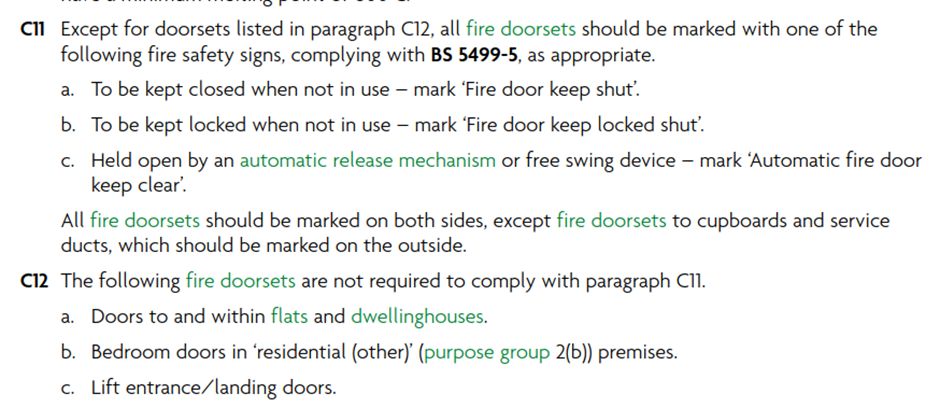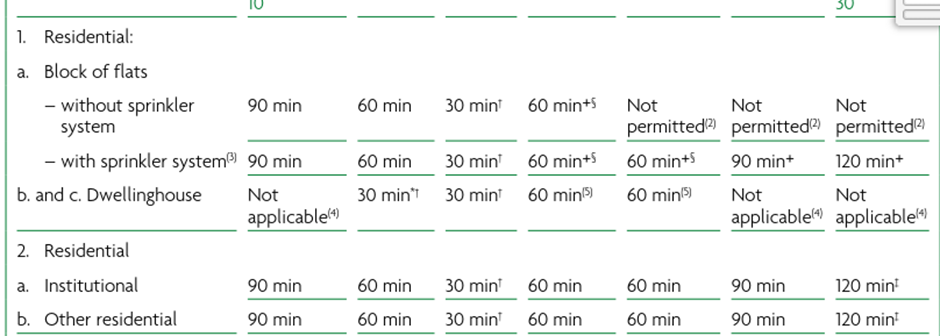
Mike North
Power Member-
Posts
329 -
Joined
-
Last visited
Everything posted by Mike North
-
All depends on what they are made of and size and is there an alternate escape? You really need a fire risk assessment
-
Best way is to stop scrimping and install new door sets
-
As long as the frame meets the minimum requirements in the manufactures installation instructions then yes
-
-
The first question is what is wrong with the door? I am seeing far too many supposedly competent inspectors saying that because a door isn’t up to modern standards that they need to be replaced, they don’t, often some minor modifications can make them acceptable. As long as the installer is competent, they need not have 3rd party accreditation, but for doors you need someone like BM Trada or FIRAS if want a certified installation. As far as I know FENSA only deal with external doors and windows
-
There should be 60 minute separating occupies
-
What does your lease say. Usually the internal doors would be the responsibility of the tenant
-
Fire Risk Assessment required for empty building?
Mike North replied to a topic in Fire Risk Assessments
December 2008 DUTY TO VISITORS AND TRESPASSERS 8.100 Occupiers’ liability duty to visitors and trespassers A duty of care is owed between an occupier of premises and his/her lawful visitors [note 1], and an occupier also owes a limited duty of care to trespassers [note 2]. The question of who is an occupier depends upon the particular facts of each case but generally it would be the person who is in actual occupation for the time being, or who has possession or physical control of the premises. Accordingly, unless and until an insolvency practitioner is appointed, the official receiver is likely to be the occupier of the premises of the insolvent, if they have been vacated by the insolvent. 8.101 Meaning of ‘duty of care’ An occupier owes the ‘common duty of care’ to all his/her visitors. This is a duty to take such care (as is reasonable in the circumstances of the case), to see that the visitor will be reasonably safe in using the premises for the purposes for which he/she is invited or permitted by the occupier to be there [note 3]. The duty of care to trespassers arises only when the occupier is aware of a danger or has reasonable grounds to believe that it exists, knows or has reasonable grounds to believe that a trespasser may be, or come into the vicinity of danger and, in all the circumstances of the case, the risk of a trespasser coming into the vicinity of the danger is one against which the occupier may reasonably be expected to offer some protection [note 4]. The occupier’s duty also extends to anyone who suffers injury as a result of any danger arising due to the state of the premises or things done or omitted to be done on the premises, even if the person suffers injury on an adjoining highway, private road or premises. There is further imposed a liability for damage to property brought onto the premises by a visitor, whether or not the property belongs to the visitor [note 5], but this liability is not imposed in relation to trespassers [note 6]. Therefore, a trespasser or other uninvited entrant cannot make a claim for damage to property. 8.102 Duty to visitors and trespassers where property leased/rented by insolvent In addition to the above duties of care and any other duty of care, there is a liability for defective premises, which could be relevant if the insolvent was a landlord in respect of any premises [note 7]. This provides that a duty of care is owed by a landlord to visitors, and possibly trespassers, where the premises are let under a tenancy which places the landlord under an obligation to the tenant for the maintenance or repair of the premises or where the landlord has the right to enter the premises and carry out such repairs. The duty arises when there has been a breach of that obligation to repair (or failure to exercise the right of repair) which has led to the defect in the premises which caused an injury to, or damage to the property of, the tenant or visitor or any other person who might reasonably be expected to be affected by defects in the premises. This duty only applies if the landlord knew or ought in the circumstances to have known of the relevant defects. The duty cannot be excluded and the official receiver as liquidator, receiver and manager or trustee may become subject to it. -
I can’t imagine the difference between the tests in order to approve one for domestic and not for commercial. I would be very interested as I may have to rip out 40,000 doors.
-
Opening problem with newly adjusted fire doors
Mike North replied to Hugh Sanderson's topic in Landlords
Something does not sound right. The gaps may now be correct, but if it can no longer function as a door, it’s no use to man not beast. The closer should be strong enough to latch the door without slamming and it should be easily openable (30N). Try smearing a thin film of petroleum jelly on the fin seal as they are sometimes stiff when first fitted. -
Fire Risk Assessment required for empty building?
Mike North replied to a topic in Fire Risk Assessments
Yes a FRA is still required as there is a higher risk of arson etc. You still have a duty of care to trespassers Fire Safety For Empty Buildings - Dorset Fire Protection -
Without accelerant the surface spread of flame over a glass panel would be zero as glass is none combustible, however the surface coating and/or frame/panel holding the glazing in place would need a statement from the supplier/installer/manufacturer
-
The only thing I can think of is if your door encroaches on to the final exit door when it is opened, that could probably be solved by hanging the door the other way.
-
Are you breaking the law? Technically yes, but I doubt that the fire police will ever inspect the property again. The issue will be if you ever have a fire, it will invalidate the insurance and may lead to prosecution as you have knowingly removed a life safety device, or when you sell the property they will have to be replaced. There are alternatives such as a suppression system, but all are far more expensive
-
You need BR Appendix C, table C1 page 153
-
Liability for doors failing fire safety review
Mike North replied to a topic in Fire Doors and Accessories
A competent fire door inspector would be able to make an opinion as to whether a fire door is up to standard by a visual inspection to declare the door as a “Nominal” fire door based on the weight thickness and construction. Usually, a monthly fire door check is little more than a visual user inspection looking for obvious defects. There should be a 6 monthly inspection the checks all aspects of the door including gap sizes. The gaps of +2 to +4 have been standard for at least the last 20 years, Attached from a Halspan certificate January 2008 -
Liability for doors failing fire safety review
Mike North replied to a topic in Fire Doors and Accessories
On a further point As for the door certification, this is a legal requirement under regulation 38 and should of been included in the OEM pack at handover by the developer. -
Liability for doors failing fire safety review
Mike North replied to a topic in Fire Doors and Accessories
I have to agree to a certain extent with the developer, the fire doors should have been inspected every six months (BS 9999, I.6.2 Fire doors) they should have been inspected 12 times. Did any statutory inspection pick up these defects? And why did you not go back to the builder with this information. You may have recourse to the party that conducted the previous risk assessments for the building if they did not highlight the defects to the doors. -
Fire door sets never fit openings
Mike North replied to Chris562's topic in Fire Doors and Accessories
To ensure that the door fits, each door is measured. Lead times are currently running at 8 to 12 weeks for a fully certified door. Generally, the have a range of standard door sizes, but you still have to measure the opening to find out which standard door will fit. We have several options whilst waiting for a delivery, enhance repair the door, replace with a blank door, close the bedroom, close the flat, close the building or keep a waking watch. -
Fire door sets never fit openings
Mike North replied to Chris562's topic in Fire Doors and Accessories
From what I have found in my experience, even with modular builds, off the shelf doorsets seldom fit without modification. That’s why we measure every door that fails before ordering the new door. It works out cheaper in the long run. -
All fire doors must be either 1 Self closing 2 Keep locked shut Perko closers are no longer permitted as closers on fire doors since they don’t latch the door from a narrow angle.
-
Fire door sets never fit openings
Mike North replied to Chris562's topic in Fire Doors and Accessories
That's why you survey, measure the door and then order the correct size -
Fire door sets never fit openings
Mike North replied to Chris562's topic in Fire Doors and Accessories
There should be minimal adjustment to the leaf or frame if the door is correctly measured. The frame should be fixed and seal to the opening giving a door to frame gap of 2 to 4 mm. As Neil says if the surveyor dose a decent job there should little adjustment, unless you are installing door blanks -
If it is only a toilet then no, if it has a cloakroom attached then yes
-
Provided you get building reg approval, as many as you want.


